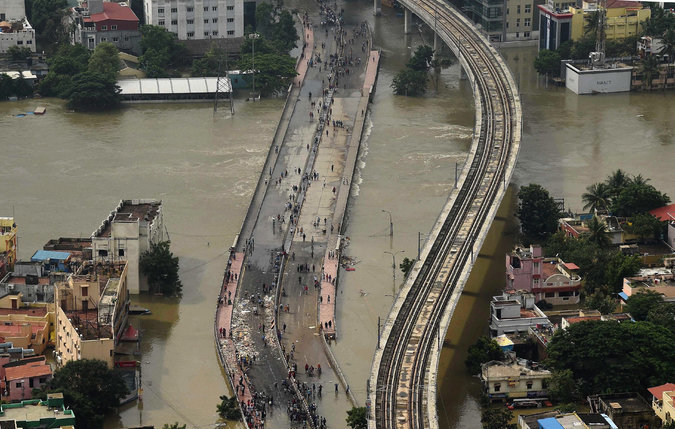
Prime Minister Narendra Modi traveled to Chennai to assess the flooding on Thursday, as the death toll reached 269 in the surrounding state of Tamil Nadu, said the home minister, Rajnath Singh, in an address to Parliament.
Heavy rains began in Tamil Nadu on Nov. 12, said Laxman Singh Rathore, the director general of India's Meteorological Department, part of a monsoon season that lasts in the region until late December. Nearly 14 inches of rain fell in Chennai on Wednesday, he added.
Schools and the airport have been closed, and the state government advised private companies in Chennai and two other districts to declare a holiday on Thursday and Friday, the Press Trust of India reported.
"The rains have broken the past 100 years' record, and this has created an unprecedented emergency situation in Chennai," Mr. Singh said.
The Indian Navy opened a naval air base to conduct rescue and relief efforts after heavy rainfall shut down Chennai's international airport.
While officials blamed the unusually heavy rainfall for the disaster, critics of the local government said the city was frequently hit with heavy rains this time of year and cited unchecked and ill-advised development as contributing greatly to the death and destruction. The airport, for one example, was built in recent years on what they said was a flood plain of the Adyar River, according to a report that appeared in Quartz.
Sunita Narain, the director general of the Center for Science and Environment based in Delhi, said in a statement on Thursday that "urban sprawls," including Chennai, too often neglected bodies of water in their development, and that the lakes in and around Chennai had a natural channel to drain floods.
"But we have built over many of these water bodies, blocking the smooth flow of water," she said in the statement. "We have forgotten the art of drainage. We only see land for buildings, not for water."
The government mobilized 30 teams of the National Disaster Response Force, many of whom traveled the city's streets in boats; seven columns of its army; and 12 navy ships in Chennai and other affected areas in the region, Mr. Singh said. Rescue operations were hampered by flooding and the resulting damage to roads in the area.
The National Disaster Response Force rescued about 3,000 people from their homes in Chennai on Wednesday, said S. P. Selvan, the deputy inspector general in southern India.
Mr. Rathore said that the cumulative effects of the rains in Chennai and its surrounding areas since Nov. 12 were in all likelihood the heaviest in a century, though deluges this time of year are the norm.
Comparably heavy rains fell around this time in 1997 and 1976, he said.
The rains moved from Chennai to more southern districts on Thursday, and heavy rains would continue to fall for the next two days, he said.



Reader Comments
to our Newsletter